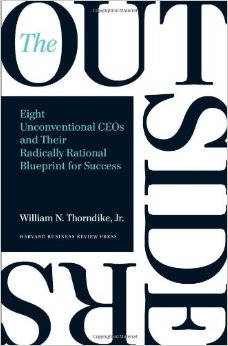I/ The Era of Anders at General Dynamics, an Example of Exceptional CEO Performance

When Anders joined the company he had already acquired a stellar pedigree. He was the photographer of “Earth rise” when he was orbiting the moon as an astronaut.
He held multiple corporate functions in different companies, such as General Electric, and was called in at General Dynamics. For the first year, with the help of Bain and Company, he interviewed key decision-makers both at General Dynamics and within the defense industry. He came to the conclusion that the defense market was suffering from overcapacity. From this, he formed three critical strategic tenets which would direct his decision-making while he was CEO:
- First of all, the company should focus on taking the leadership position in any market where it’s a player
- Second of all, the company should sell non-core assets which do not produce high returns
- Third of all, the company should operate in markets where it has significant strategic, operational and technical competencies both at the management level and on the field.
Based on these three strategic tenets, Anders set out to achieve two different goals:
- cash generation
- efficient capital deployment
II/ Cash generation
In order to generate cash, Anders focused on multiple levers:
- first of all, he made sure that operations weren’t spending too much. In walking through manufacturing plants, he realized that the company had purchased too much inventory. For example, in some cases, the company had purchased several canopies, the glass used for the cockpit, for every single plane. He enforced a new rule: no more than two canopies per aircraft.
- Second of all, he changed the allocation approval process so that each project would include a return on interest estimate.
- He also conducted a vast headcount reduction by reducing corporate headquarter-headcount by 60%.
- In addition, he relocated the company’s headquarters to Northern Virginia in order to be closer to defense decision-makers
These actions helped him generate $2.5 billion in cash.
He then reverted to divestiture in order to generate more cash. Applying the strategic tenets, he sold multiple non-core assets producing low returns including: IT divisions, the Cessna aircraft business and the missiles and electronics businesses. These divestitures generated $2.5 billion in cash.
Anders was able to generate $5 billion in cash by tightening operations and selling non-core assets.
III/ Capital deployment
Once he generated $5 billion in cash, the question arose of how to deploy the capital. He basically hesitated between two alternatives:
- first of all, he could use the capital to acquire companies
- second of all, he could provide dividends to shareholders.
Anders decided to reward shareholders by a combination of dividends and stock repurchases. He announced a gigantic $1 billion tender to repurchase 30% of the company’s shares. In other words, in less than three years, Anders had dramatically “streamlined operations, sold off over half of his company, generated $5 billion in proceeds, and, rather than redeploying the cash into R&D or new acquisitions, returned most of it to shareholders, using innovative, tax-efficient techniques”, writes William Thorndike, author of The Outsiders: Eight Unconventional CEOs and Their Radically Rational Blueprint for Success.
This pretty much summarizes Anders’s time as CEO of General Dynamics. He retired and asked Mellor to take on his position as CEO.
IV/ Minimizing corporate risks through targeted acquisitions
When the new CEO joined the company, he first set out to initiate acquisitions. The company targeted startups and small companies which had the potential to strengthen General Dynamics’s businesses and expertise. By 1995, Mellor reinitiated an acquisition wave which culminated with the $400 million acquisition of Bath Iron Works, one of the largest domestic builders of navy ships.
This ended Mellor’s term as CEO. He turned on to Nick Chabraja, one of the most “effective business-like lawyers”, according to Anders.

Chabraja set ambitious goals for himself when he became CEO. Specifically, he aimed at quadrupling the company’s stock price in 10 years, which is equal to a 15% compound rate of return. It turns out that fewer than 5% of Fortune 500 companies had achieved such performance in the last 10 years. In order to achieve his goal, he reverted to 2 levers:
- Internal change, including organic growth and increased operational excellence
- Targeted acquisitions
In leading internal transformation, Chabraja continued on the same path as his predecessors, Anders and Mellor. But Chabraja’s take on acquisitions was distinctly different: “our strategy has been to aggressively pursue targets directly related to our core businesses … broadening our product line into adjacent spaces”. In the first years, Chabraja acquired 12 companies.
In 1999, Chabraja went a step further. Instead of acquiring small companies, he led a $5 billion purchase of Gulfstream, the world’s largest commercial jet manufacturer. Chabraja felt that commercial aviation, which “promised excellent long-term growth trends, would provide significant diversification against fluctuations in defense spending”, thereby minimizing corporate risk across all business lines, according William Thorndike, author of The Outsiders: Eight Unconventional CEOs and Their Radically Rational Blueprint for Success.
On a more general note, Vernon informed me that Bain studied “32 companies that undertook full potential transformations. These companies boosted sales by 23%, on average, while growth in EBIT made a U-turn, from an average annual decline of 16% in the years preceding their transformations to 20% annual EBIT growth in the subsequent two years.”
V/ Exceptional CEO Performance : Achieving 23.3 percent compound annual return—in a Nutshell
In a nutshell, in order to achieve superior corporate performance in a fluctuating and unpredictable market, CEOs can conduct the following actions:
- tightening operations all along the value chain from resource acquisition, production, marketing, sales and distribution
- reducing headcount without deteriorating the product offering and differentiation
- relocating corporate headquarters near to client headquarters
- deploying cash in order to reward shareholders when the industry mood leads to undervaluing corporate stocks
- repurchasing corporate stocks when they are undervalued
- acquiring targeted companies in order to strengthen businesses and competences while these companies it seemed undervalued
- diversifying to new market spaces which require similar technical expertise but which may not be subject to the same market fluctuations in order to minimize corporate risk all along business lines.
This pretty much summarizes my understanding of General Dynamics’s transformation.
No comment